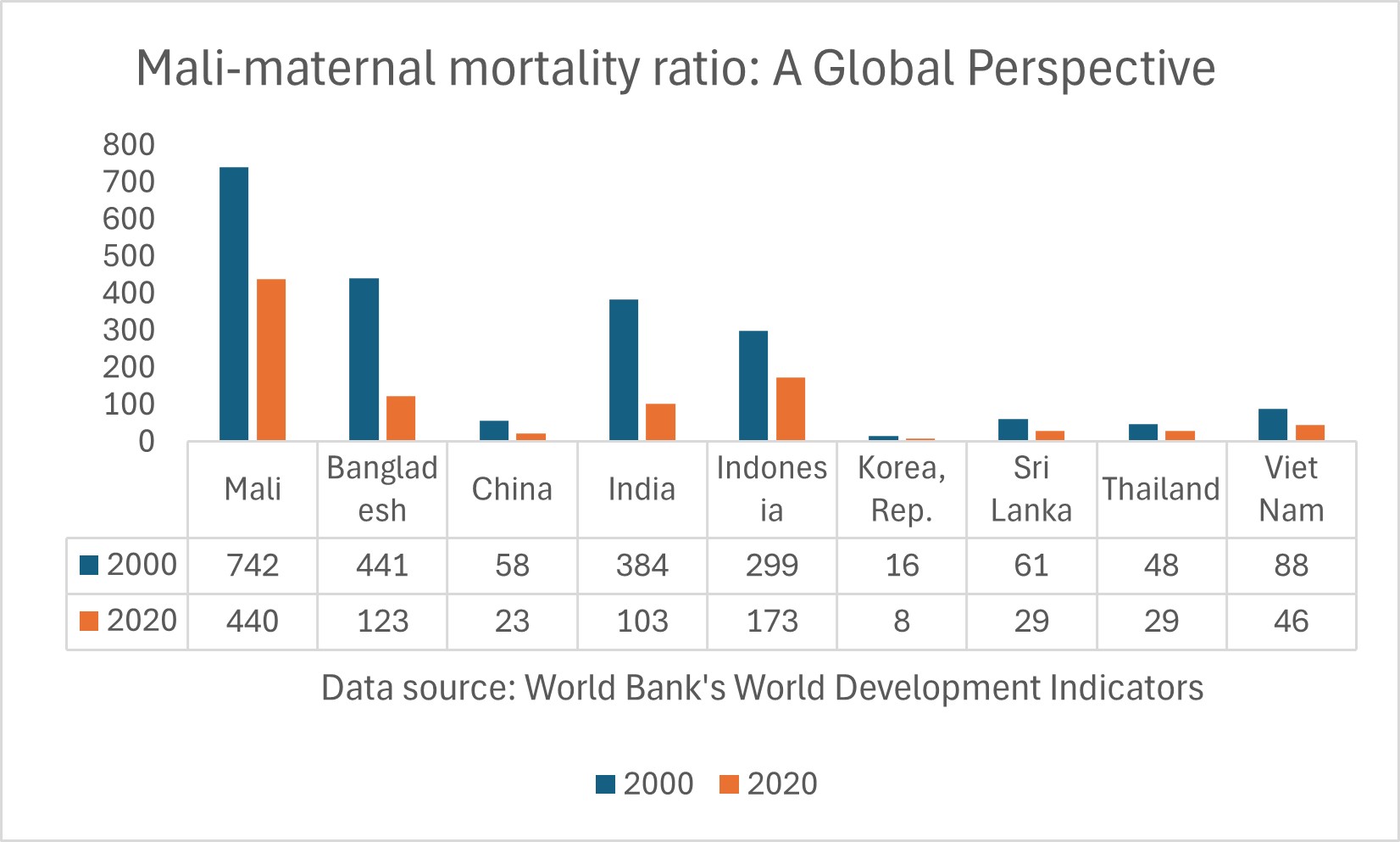
Mali
Country Flag Details three equal vertical bands of green (hoist side), yellow, and red
note: uses the popular Pan-African colors of Ethiopia; the colors from left to right are the same as those of neighboring Senegal (which has an additional green central star) and the reverse of those on the flag of neighboring Guinea.
Background Mali is named for the Mali Empire that at its peak in the 14th century covered an area
about twice the size of modern-day France.
In the late 19th century, France seized
control of Mali. The Sudanese Republic and
Senegal became independent of France in
1960 as the Mali Federation. When Senegal
withdrew after only a few months, the former
Sudanese Republic was renamed Mali.
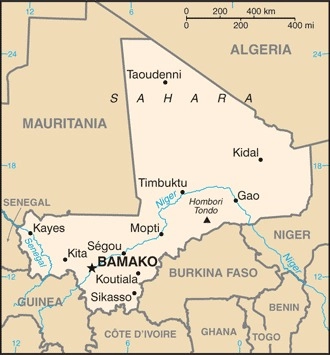
Geography
Area
total : 1,240,192 sq km
land: 1,220,190 sq km
water: 20,002 sq km
Climate
subtropical to arid; hot and dry (February to June); rainy, humid, and mild (June to
November); cool and dry (November to
February)
Natural resources
gold, phosphates, kaolin, salt, limestone,
uranium, gypsum, granite, hydropower
People and Society
Population
total: 21,990,607
Ethnic groups
Bambara 33.3%, Fulani (Peuhl) 13.3%,
Sarakole/Soninke/Marka 9.8%,
Senufo/Manianka 9.6%, Malinke 8.8%,
Dogon 8.7%, Sonrai 5.9%, Bobo 2.1%,
Tuareg/Bella 1.7%, other Malian 6%, from
members of Economic Community of West
Africa 0.4%, other 0.3% (2018 est.)
Languages
Bambara (official), French 17.2%,
Peuhl/Foulfoulbe/Fulani 9.4%, Dogon 7.2%, Maraka/Soninke 6.4%, Malinke 5.6%, Sonrhai/Djerma 5.6%, Minianka 4.3%, Tamacheq 3.5%, Senoufo 2.6%, Bobo 2.1%, other 6.3%, unspecified 0.7% (2009 est.)
Religions
Muslim 93.9%, Christian 2.8%, animist 0.7%, none 2.5% (2018 est.)
Population growth rate
2.9% (2024 est.)
Government
Government type
semi-presidential republic
Capital name: Bamako
Executive branch
chief of state: Transition President Assimi
GOITA (since 7 June 2021)
head of government: Transition Prime
Minister Choguel MAIGA (since 7 June
2021)
Economy
Real GDP (purchasing power parity)
$56.919 billion (2023 est.)
$54.387 billion (2022 est.)
$52.56 billion (2021 est.)
Real GDP per capita
$2,400 (2023 est.)
$2,400 (2022 est.)
$2,300 (2021 est.)
Exports $5.855 billion (2022 est.)
$5.381 billion (2021 est.)
$5.196 billion (2020 est.)
Exports – partners
UAE 73%, Switzerland 15%, Australia 5%,
China 1%, Uganda 1% (2023)
Exports – commodities
gold, cotton, oil seeds, fertilizers, gum resins (2023)
Imports
$7.942 billion (2022 est.)
$7.596 billion (2021 est.)
$6.339 billion (2020 est.)
Imports – partners
Cote d’Ivoire 25%, Senegal 19%, China
12%, France 5%, Burkina Faso 4% (2023)
Imports – commodities
refined petroleum, broadcasting equipment,cement, cotton fabric, plastic products (2023)

Export structure by product group in 2023 (% of total export) (UNCTAD)
Mali’s export structure provides a comprehensive view of the diversity, composition, and value of the goods and services that the nation sells to international markets, thereby offering vital insights into the overall health of its economy and the level of its development. The economy is significantly anchored by a select few key products, with gold standing out as the predominant export, followed closely by cotton, livestock, and fertilizers. This heavy reliance on a limited range of commodities presents inherent risks that could destabilize economic progress. To counteract these vulnerabilities and foster a more resilient economic landscape, efforts are actively being pursued to diversify Mali’s export portfolio, aiming for a more balanced and sustainable growth trajectory that can withstand fluctuations in global markets.
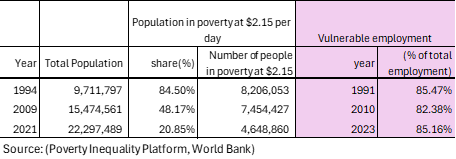
Poverty and vulnerable employment in Mali (World Bank)
Understanding Poverty Level Significance at $2.15 per day
In 2021, nearly 21 percent of the Mali’s population lived in poverty at $2.15 per day. The poverty level at $2.15 per day (measured in 2017 purchasing power parity, or PPP) is a key global benchmark used by the World Bank to define extreme poverty in low-income countries. It indicates:
1. Basic Survival Threshold
• People living below $2.15 per day struggle to afford essential needs such as food, clean water, shelter, healthcare, and education.
2. Economic Underdevelopment
• A high percentage of a country’s population living below this threshold suggests low economic productivity, high unemployment, and weak social safety nets.
3. Inequality and Social Vulnerability
• It reflects deep income inequality and a lack of access to opportunities for upward mobility.
• People in this category are more vulnerable to shocks like food price increases, climate disasters, or health crises.
4. Policy Challenges
• Governments need targeted interventions such as social welfare programs, job creation, and improved access to education and healthcare to reduce poverty.
A country's export structure is a reflection of its level of development and productive capacities
The export structure of a country refers to the composition, diversity, and value of the goods and services it sells to other countries. It provides key insights into the country’s economic health, competitiveness, and level of development. Productive capacities of a country refer to its ability to produce goods and services efficiently and sustainably over time. These capacities are shaped by various factors, including human capital, natural resources, infrastructure, private sector, development, technology & innovation, institutions & governance, financial systems trade & market access.
Here’s what the export structure and productive capacities of a country typically indicate:
- Level of Economic Development
- Developed economies usually export high-value manufactured goods, technology, and services.
- Developing economies often rely on raw materials, agricultural products, or low-value manufactured goods.
- Industrial and Sectoral Strengths
- A strong presence of high-tech or industrial goods (e.g., machinery, electronics) suggests a well-developed manufacturing sector.
- A dominance of commodities (e.g., oil, minerals, agricultural products) indicates reliance on natural resources.
- Export Diversification
- A diverse export base (multiple industries) makes a country’s economy more stable and resilient to global price shocks.
- A concentrated export base (few key products) makes it vulnerable to market fluctuations.
- Trade Partnerships and Dependence
- If exports are heavily dependent on a single country or region, the economy is more exposed to geopolitical and trade risks.
- A wide range of trading partners indicates stronger global integration.
- Competitiveness and Value Addition
- Exporting mainly raw materials (e.g., crude oil instead of refined petroleum) suggests limited industrial processing capacity.
- A high share of finished and high-tech goods suggests strong value addition and competitiveness.
Mali-Sanitation
Mali – Proportion of population served with at least basic sanitation
In 2022, proportion of population served with at least basic sanitation for Mali was 50.2%. Proportion of population served with at least basic sanitation of Mali increased from 15.1% in 2000 to 50.2 % in 2022%, an absolute change of 35.1 percentage points (pp) between 2000 and 2022.
Mali – Proportion of urban population served with at least basic sanitation
In 2022, proportion of urban population served with at least basic sanitation for Mali was 60.2 %. Proportion of urban population served with at least basic sanitation of Mali increased from 34.0 % in 2000 to 60.2 % in 2022, an absolute change of 26.2 pp between 2000 and 2022.
Mali – Proportion of rural population served with at least basic sanitation
In 2022, proportion of rural population served with at least basic sanitation for Mali was 41.9 %. Proportion of rural population served with at least basic sanitation of Mali increased from 8.1 % in 2000 to 41.9 % in 2022 an absolute change of 33.8 between 2000 and 2022.
Mali- Proportion of total population with at least basic sanitation: A Global Perspective
In 2022, over 11 million people in Mali, nearly half the population, struggled with inadequate sanitation facilities, a stark contrast to nations like Vietnam, China, Sri Lanka, and Thailand, where only 8 percent, 4 percent, 5 percent, and just 1 percent lacked these essential services. With a global average of about 6 percent, the urgent need for collaborative efforts to improve sanitation access in Sub-Saharan Africa is evident. The absence of safe sanitation is not just a challenge, it is a critical crisis leading to the avoidable deaths of hundreds of thousands each year, underscoring a significant public health emergency. Access to safe sanitation is a fundamental human right that everyone deserves, highlighting our shared responsibility to address this urgent issue with compassion and urgency in Sub-Saharan Africa.
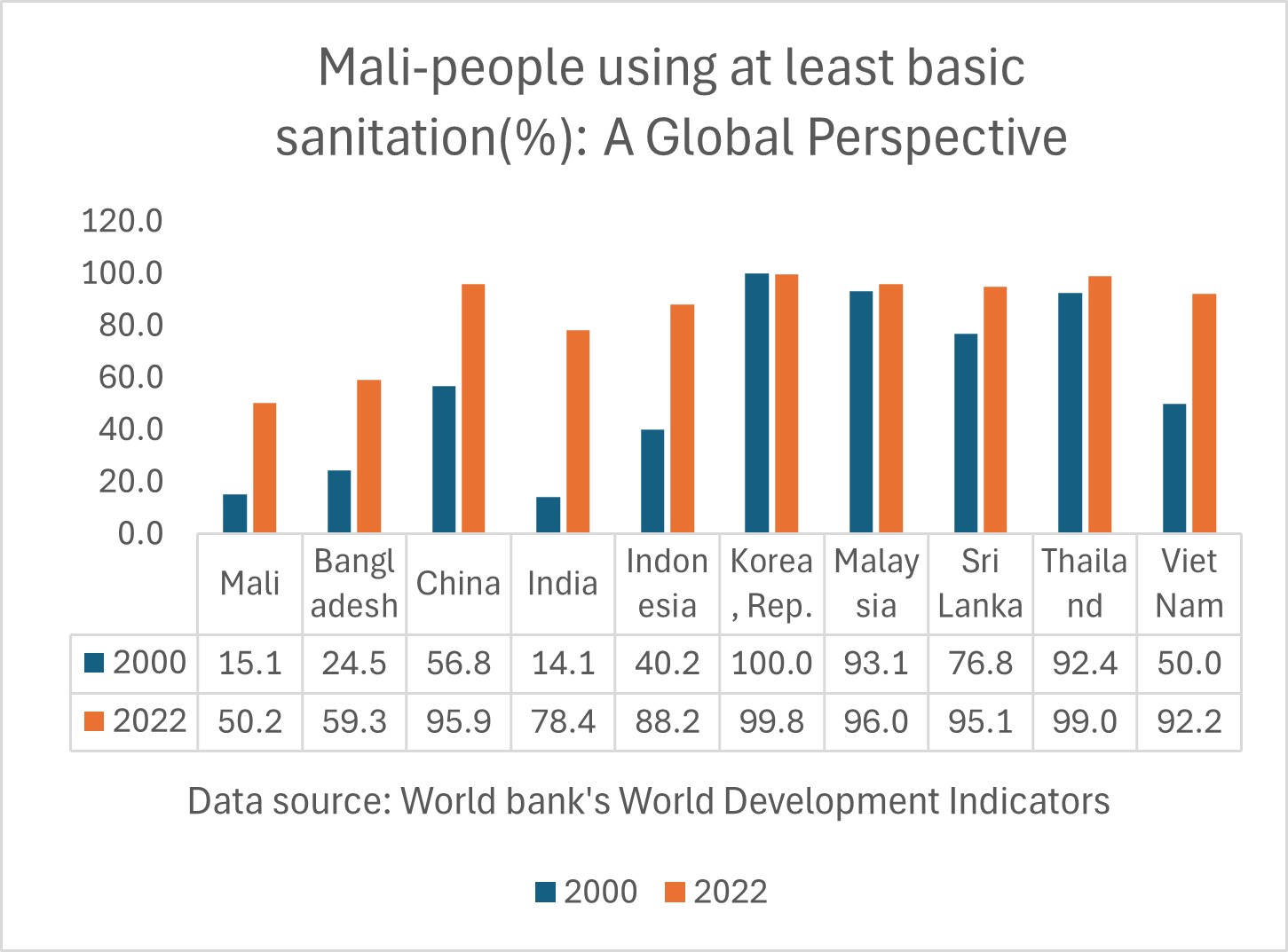
Mali- Proportion of rural population with at least basic sanitation: A Global Perspective
The absence of safe sanitation is a critical issue that demands urgent attention as it results in the preventable deaths of countless individuals each year, illustrating a serious public health crisis that requires immediate action to safeguard our communities. Access to safe sanitation is a fundamental human right that everyone should enjoy without exception. In 2022, nearly 5 million people in rural Mali, or about 58 percent of the population, lacked basic sanitation facilities, highlighting a stark contrast to the much lower rates in Vietnam, Sri Lanka, and Thailand at 12 percent, 5 percent, and 2 percent respectively. We must unite to advocate for this essential right across Sub-Saharan Africa, where the need is critical and the potential for transformative change in communities is significant, leading to a healthier and more equitable future for all.
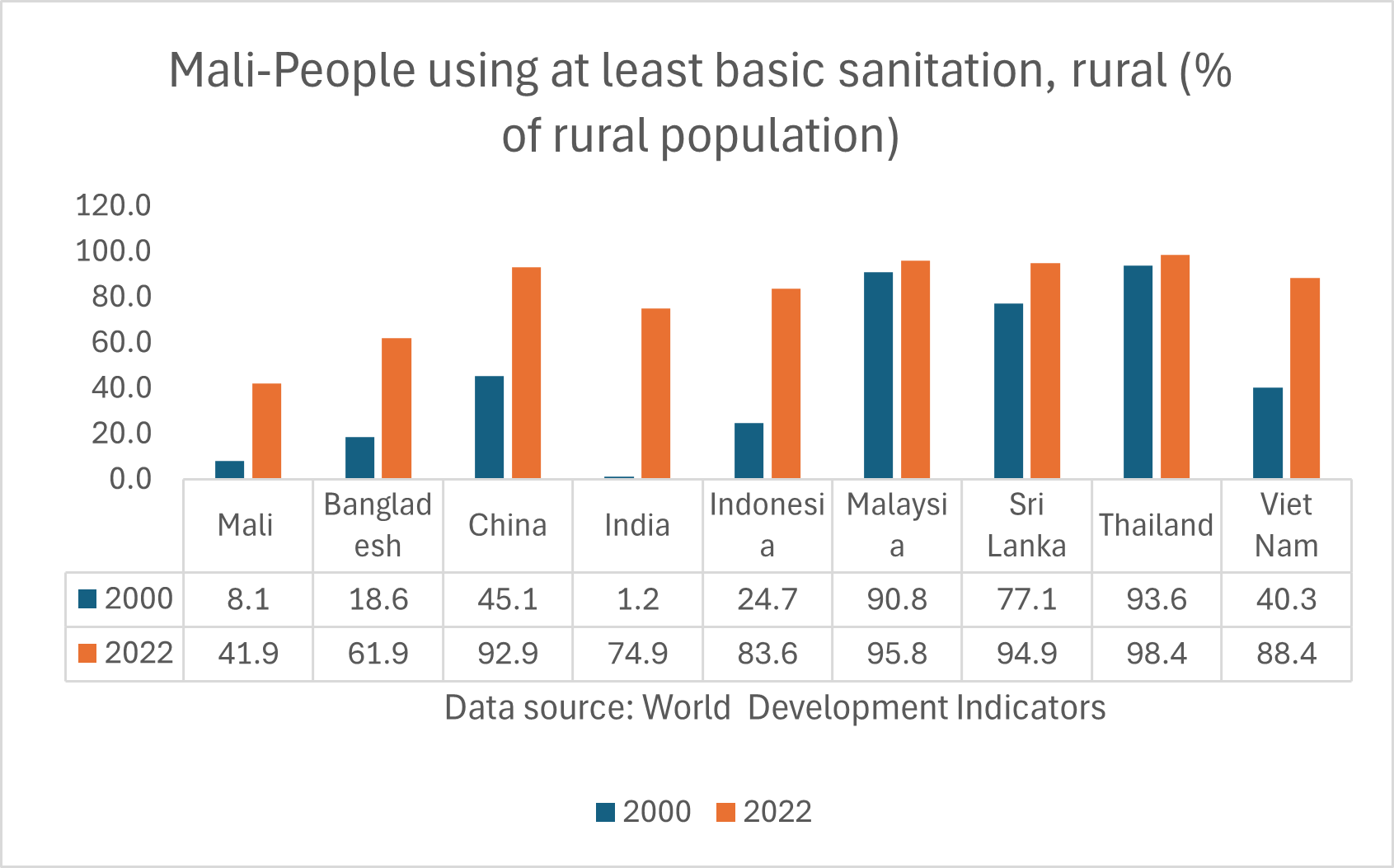
Mali-Water Supply
Mali – Proportion of total population served with at least basic water
In 2022, proportion of population served with at least basic water for Mali was 83.6 %. Proportion of population served with at least basic water of Mali increased from 49.9 % in 2000 to 83.6 % in 2022 an absolute percent change of 33.7 pp between 2000 and 2022.
Mali – Proportion of urban population served with at least basic water
In 2022, proportion of urban population served with at least basic water for Mali was 94.7 %. Proportion of urban population served with at least basic water of Mali increased gradually from 77.2 % in 2000 to 94.7 % in 2022, an absolute change of 17.5 pp between 2000 and 2022.
Mali- Proportion of rural population with at least basic water
In 2022, proportion of rural population served with at least basic water for Mali was 74.4 %. Proportion of rural population served with at least basic water of Mali increased from 39.1 % in 2000 to 74.4 % in 2022 an absolute percent change of 35.3 pp between 2000 and 2022.
Mali- Proportion of total population with at least basic drinking water: A Global Perspective
Mali is facing a severe crisis in accessing basic water services, reflecting a troubling global trend. In 2022, nearly four million people in Mali, about 16 percent of the population, struggled to obtain this vital resource, revealing stark inequalities that many take for granted. In contrast, everyone in Thailand has access to safe drinking water, with 98 percent of individuals in Bangladesh and Vietnam also enjoying this right. Safe drinking water is a fundamental human right essential for health and well-being. These disparities underscore the urgent need for compassionate and systematic efforts to improve living conditions and ensure equitable access to safe drinking water for marginalized communities across Sub-Saharan Africa, where the impact of such inequities is severe.
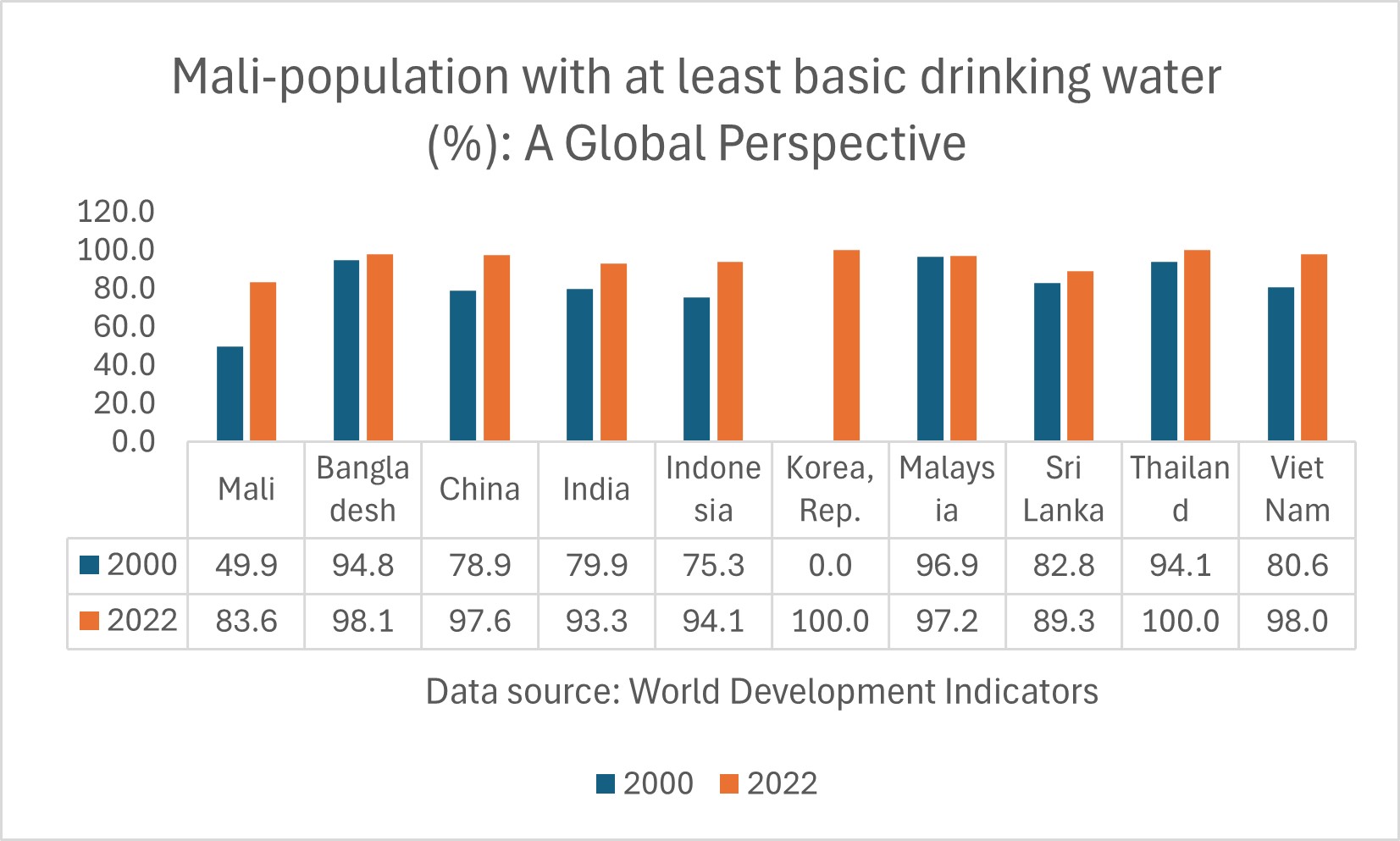
Mali- Proportion of rural population with at least basic drinking water: A Global Perspective
In 2022, it was disheartening to discover that 26 percent of Mali’s rural population, around 3 million people, lacked access to safe drinking water. This stands in stark contrast to countries like Thailand and Bangladesh, where nearly all rural residents have this vital resource. This disparity highlights the significant challenges faced by many in Mali and underscores the urgent need for change across Sub-Saharan Africa. We share a responsibility to address the critical issues of water access and sustainability in the region, emphasizing the need for compassionate and effective strategies that ensure every community can secure access to safe drinking water, a fundamental necessity for health and well-being, enabling individuals and communities to prosper.
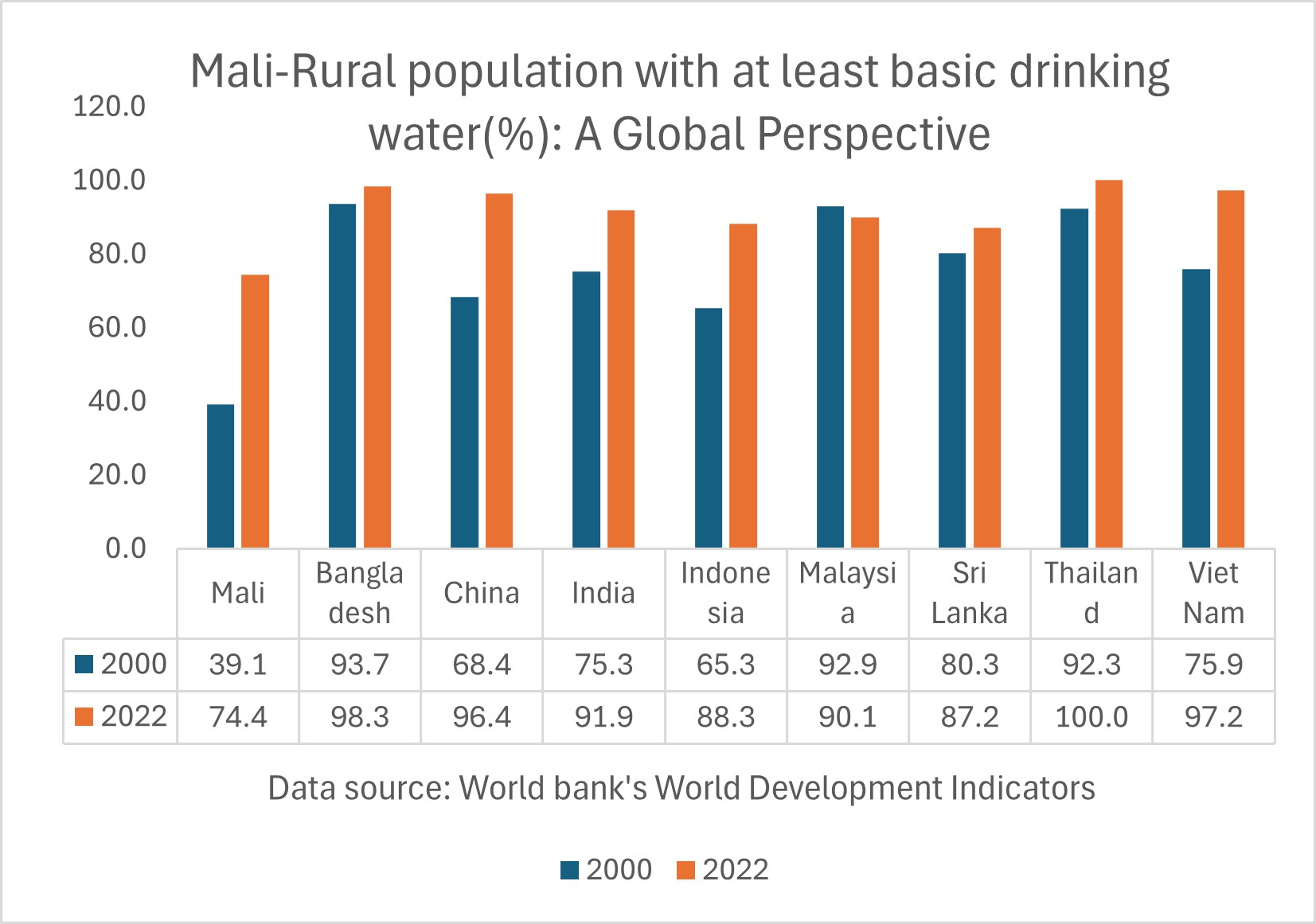
Mali-Access to electricity
Mali- Access to electricity (% of population)
In 2022, proportion of population with access to electricity for Mali was 53 %. The proportion of population with access to electricity of Mali increased from 9.6% in 2000 to 53% in 2022, an absolute change of 43.4 percentage points between 2000 and 2022.
Mali- Access to electricity (% urban population)
In 2022, the proportion of the urban population with access to electricity in Mali was 99.7%. The proportion of the urban population with access to electricity in Mali increased from 33.8% % in 2000 to 99.7% in 2022, an absolute change of 65.9 pp between 2000 and 2022.
Mali- Access to electricity (% rural population)
In 2022, proportion of rural population with access to electricity for Mali was 18.3 %. The proportion of rural population with access to electricity of Mali increased from 0.0 % % in 2000 to 18.3% in 2022, an absolute change of 18.3 pp between 2000 and 2022.
Mali-Share of total population with access to electricity: A Global Perspective
In 2022, nearly 47 percent of Mali’s population lived without electricity, underscoring the significant challenges faced in pursuing a better life. This reality starkly contrasts with the achievements of countries like Vietnam, Thailand, Sri Lanka, and Malaysia, which have reached 100 percent electricity access. The lack of reliable electricity impedes development, health, education, and economic opportunities, preventing families from realizing their full potential. Together, we can strive for a future where electricity is accessible to all, transforming lives and fostering a sustainable tomorrow.
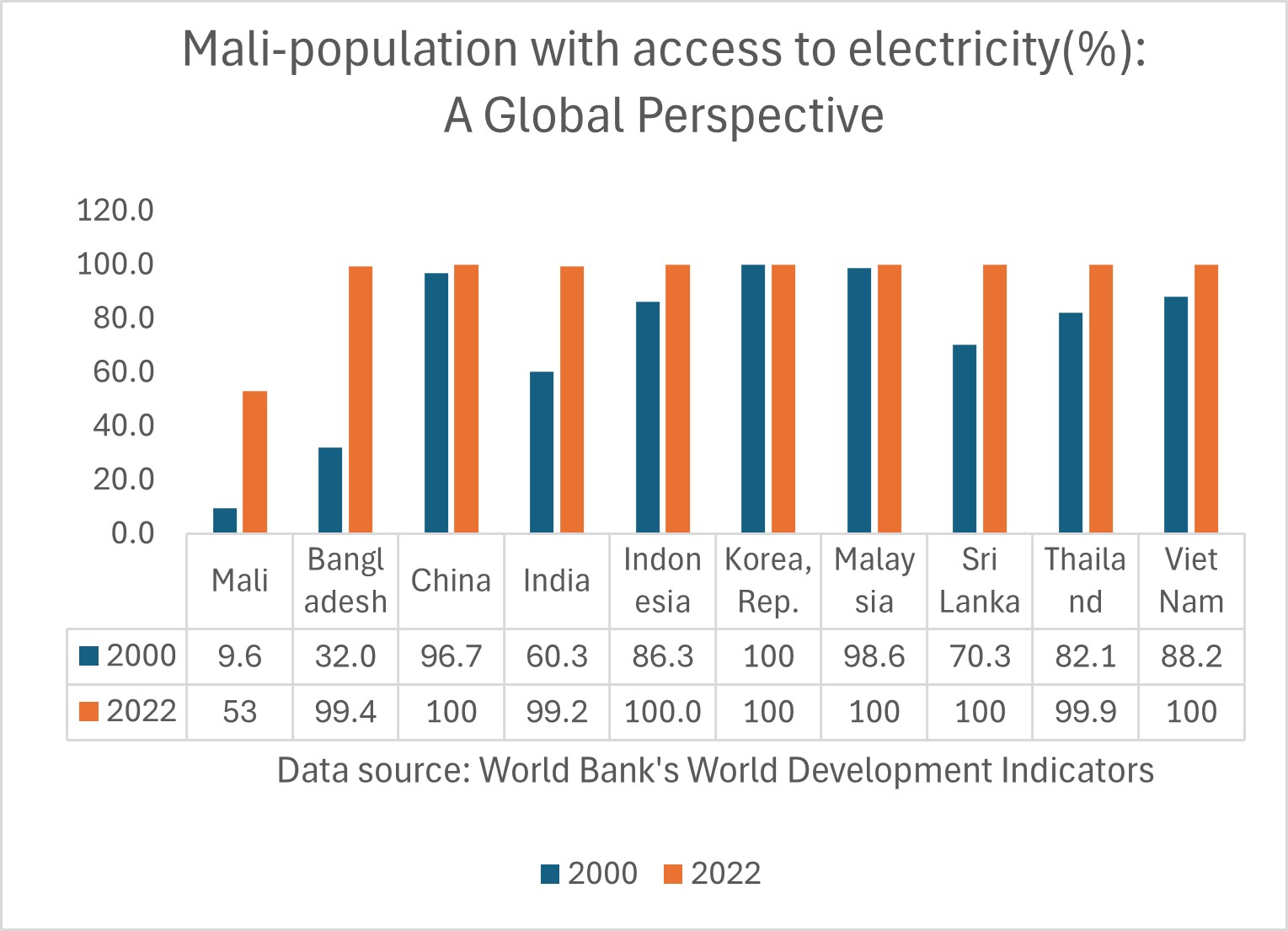
Mali-Share of rural population with access to electricity: A Global Perspective
In 2022, 82 percent of Mali’s rural population, nearly 10 million people, lived without electricity, starkly contrasting with countries like Vietnam, Thailand, and Sri Lanka, where every rural resident has this essential resource. Meanwhile, India and Bangladesh boast that 99 percent of their rural populations enjoy electricity access. These figures highlight the urgent need for transformative governance reforms across Sub-Saharan Africa, aimed at ensuring every community is connected and has reliable electricity. This change is vital for empowering these communities to thrive and move toward a sustainable future.

Mali-Health outcomes
Mali-Life expectancy: A Global Perspective
Mali’s life expectancy is a crucial example of the ongoing health disparities within Sub-Saharan Africa. Over the last seventy years, global health metrics have improved, with average life expectancy for newborns rising from 47 years in 1950 to 71 years in 2021. However, Mali’s life expectancy has only increased from 30 years in 1960 to 59 years in 2022, reflecting the significant challenges its people face. In contrast, countries like South Korea have achieved remarkable advances, with life expectancy soaring from 54 years in 1960 to 83 years in 2022, and the Maldives improving from 39 years in 1960 to 81 years in 2022. The low life expectancy in Sub-Saharan Africa highlights critical issues such as deep-rooted poverty, underfunded healthcare, and governance difficulties, necessitating urgent and transformative actions for a sustainable and equitable future.
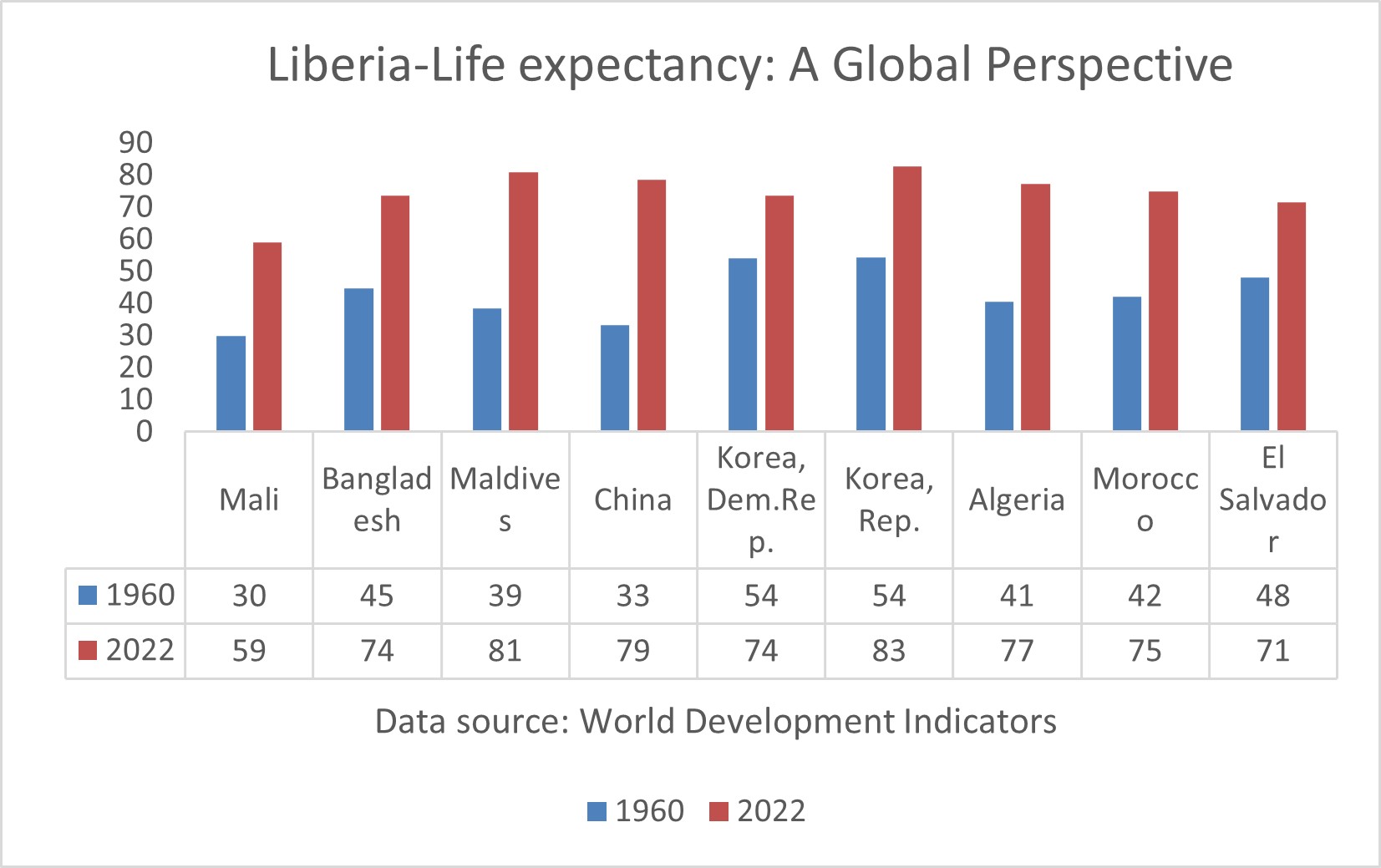
Mali-Mortality rate, under-5 (per 1000 live births): A Global Perspective
Mali’s under-five mortality rate highlights a significant global health challenge. While many developing nations in South America, Asia, and Africa have made strides over the past seventy years, Sub-Saharan Africa still faces slow progress. Mali’s rate improved from 301 per 1,000 live births in 1980 to 94 in 2022. In contrast, Bangladesh reduced its rate from 206 in 1980 to an impressive 29 in 2022, and India achieved a similar drop from 169 to 29 in the same period. Since 1950, global child mortality rates have declined due to better living standards, healthcare access, nutrition, and safe drinking water. In affluent European and American countries, rates are now below four percent, reflecting the benefits of strong healthcare systems and stable economies. These statistics reveal ongoing challenges from inadequate healthcare infrastructure, emphasizing the urgent need for structural reforms in Sub-Saharan Africa to combat child mortality and improve health outcomes.
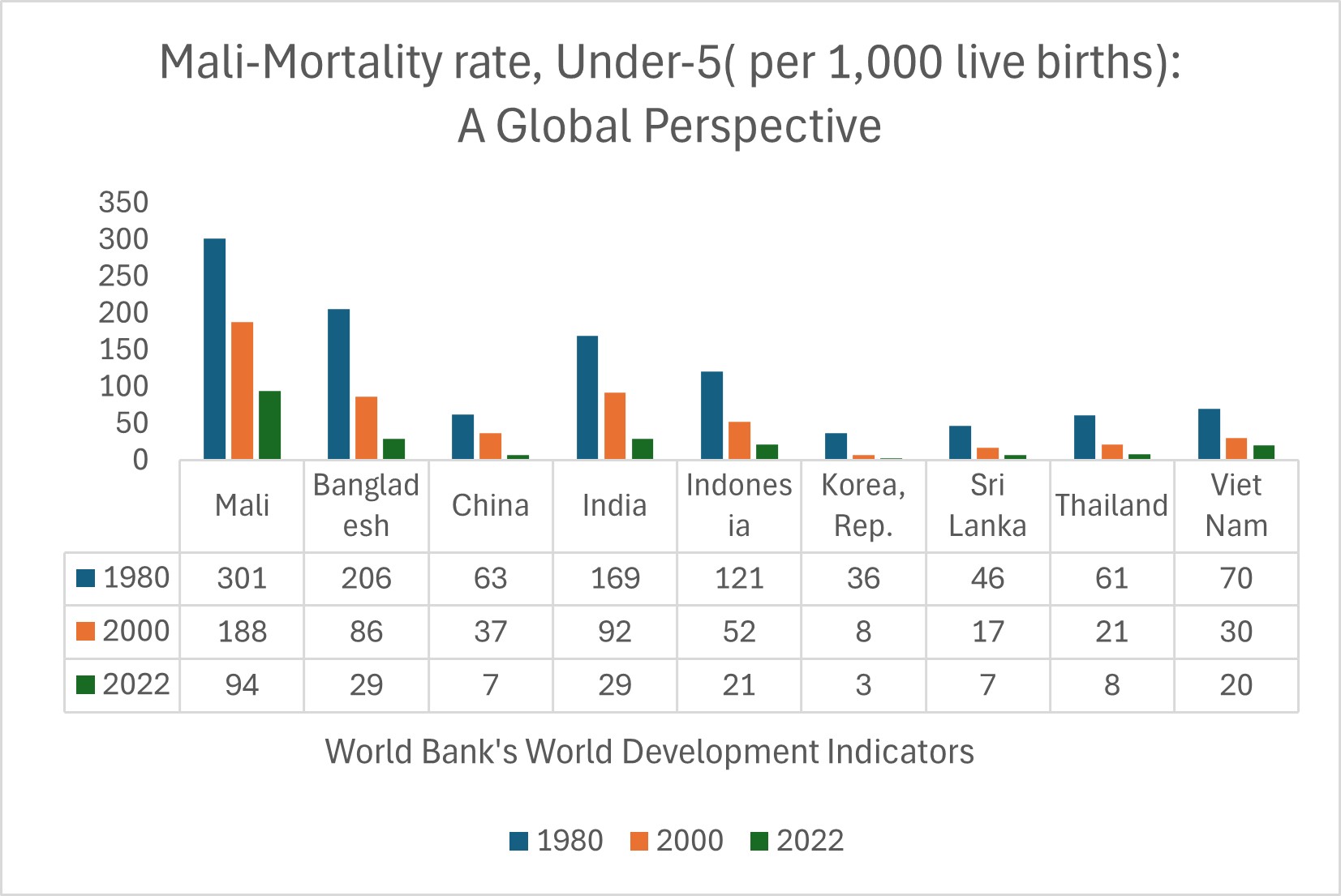
Mali-Maternal mortality ratios (per 1000,000 live births): A Global Perspective
Mali faces a critical maternal mortality ratio, reflecting the severe challenges mothers face daily. The ratio, though reduced from 742 in 2000 to 440 in 2020, remains alarmingly high compared to global standards. In contrast, Bangladesh, India, and Vietnam report significantly lower ratios of 123, 103, and 46 respectively, highlighting a stark disparity. Many mothers in Mali have tragically lost their lives to pregnancy complications, worsened by the country’s high birth rate and ongoing maternal health issues. These troubling statistics emphasize the urgent need for improved healthcare services and reveal the chronic underfunding affecting many healthcare systems in Sub-Saharan Africa. The notable differences in maternal health outcomes compared to other developing regions call for immediate systemic reform in governance and resource allocation, as the safety and well-being of mothers and their children in Mali remain critically at risk.
